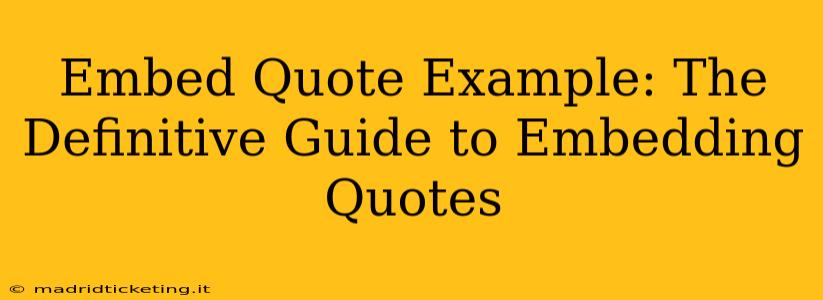Embedding quotes effectively is crucial for adding credibility, illustrating points, and injecting personality into your writing. Whether you're crafting a blog post, academic paper, or even a casual email, knowing how to embed quotes properly is essential. This guide provides a definitive approach to embedding quotes, covering various styles and contexts.
What is Embedding a Quote?
Embedding a quote means integrating a direct quotation seamlessly into your own writing. It's more than just pasting the quote; it's about presenting it in a context that enhances your overall message. Successful quote embedding requires clear attribution and proper grammatical integration. Avoid simply dropping a quote into your text without proper introduction or explanation.
Different Ways to Embed Quotes
There are several ways to effectively embed quotes, each serving a different purpose:
-
Direct Integration: This is the simplest method, where the quote becomes a grammatical part of your sentence. For example: "As Shakespeare famously wrote, 'To be or not to be, that is the question'," prompting further discussion. Note the use of commas to smoothly integrate the quote.
-
Block Quotes: For longer quotes (typically four lines or more), use a block quote. This visually sets the quote apart from your text:
"The true alchemists do not change lead into gold; they change the world into words." - William H. Gass
Notice the indentation and often the italicization used for block quotes.
-
Using Ellipses (...): When omitting parts of a quote, use ellipses to indicate the removed section. For example: "He stated, 'The situation is...extremely complex.'" Avoid using ellipses to distort the original meaning.
-
Using Brackets [ ]: Use brackets to add clarifying words or phrases within a quote without altering the original meaning. For example: "She said, 'The results [of the experiment] were inconclusive.'"
Common Mistakes to Avoid When Embedding Quotes
Several common errors can weaken the impact of your embedded quotes:
-
Incorrect Punctuation: Ensure correct punctuation around quotation marks. The placement of commas, periods, and other punctuation marks can significantly affect meaning.
-
Overusing Quotes: Too many quotes can disrupt the flow of your writing. Choose quotes strategically to emphasize key points.
-
Poor Introduction/Context: Always introduce a quote and explain its relevance to your point. Never leave a quote dangling without explanation.
-
Misattribution: Always correctly attribute quotes to their original sources. Incorrect attribution is plagiarism and can have serious consequences.
How to Properly Attribute a Quote
Proper attribution is paramount. Always cite the source using a consistent citation style (e.g., MLA, APA, Chicago). Provide the author's name and the publication or source. For example:
-
"As Dr. Martin Luther King Jr. famously said, 'Injustice anywhere is a threat to justice everywhere.'" (King, 1963).
-
For online sources, providing a URL is often necessary.
H2: How long should a quote be in an essay?
The ideal length of a quote depends on its purpose and the overall structure of your essay. Short quotes are best for illustrating a specific point, while longer quotes might be necessary for providing in-depth analysis or presenting a unique perspective. Overuse of long quotes can disrupt the flow of your writing, however.
H2: How do you cite a quote within a quote?
When citing a quote within a quote, use single quotation marks for the inner quote and double quotation marks for the outer quote. For example: "The professor stated, 'He said, "The experiment was a success,"' during the lecture."
H2: What are the rules for using quotes in academic writing?
Academic writing typically adheres to strict citation guidelines. Consult your style guide (MLA, APA, Chicago, etc.) for specific rules on quote formatting, punctuation, and attribution. Accuracy and proper citation are critical in academic settings to avoid plagiarism.
Conclusion
Mastering the art of quote embedding elevates your writing by enhancing credibility, illustrating your points convincingly, and adding a dynamic flair. By following these guidelines, you can use quotes effectively to improve the clarity and persuasiveness of your work, regardless of the context. Remember consistency, accuracy, and mindful selection are key to successfully embedding quotes.

